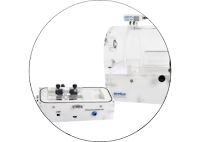Alpha-1 antitrypsin (AAT) deficiency is an inherited disorder, most prevalent in populations of European ancestry, and is underdiagnosed. It results from mutations in the SERPINA1 gene, leading to either a reduced level or function of the AAT protein. AAT deficiency results a variety of health issues, particularly predisposition to the development of liver and lung disease1. When exacerbated by smoking, this results in damage to the alveoli and ultimately emphysema with many of the features of COPD1.
The recently published
Alpha-1 Antitrypsin deficiency, in the Methods in Molecular Biology series (Springer Protocols) provides a comprehensive background to this disease and state-of-the-art methods
2, including a chapter outlining the use of the forced oscillation technique to assess lung structure and function relationships, with focus on the
flexiVent3.
Recent years have seen exciting developments in both the development of animal models for AAT deficiency research and proof of principle studies for treatment approaches. Using adeno-associated virus 2/8 to direct gene delivery specifically to mouse lung Payne et al were able to demonstrate not only elevated serum AAT but also protection against elastase-induced augmentation of compliance – measured using the
forced-oscillation technique (FOT) on the flexiVent4.
Cox et al. performed pressure-volume loops and utilised the FOT with the flexiVent to confirm the increased compliance, with LPS challenge, of a newly developed mouse model of AAT deficiency. Generated using CRISPR/Cas9 genome editing, the model demonstrates many of the hallmark features of the human disease5.
With the development of animal models which more closely resemble human disease, progress in the search for effective treatments will be greatly accelerated. SCIREQ looks forward to helping provide tools for this research.
1- Stoller, James K., and Loutfi S. Aboussouan. “A Review of α1-Antitrypsin Deficiency.”American Journal of Respiratory and Critical Care Medicine, vol. 185, no. 3, 2012, pp. 246–259., doi:10.1164/rccm.201108-1428ci.
2- Borel, F., & Mueller, C. (Eds.). (2017). Alpha-1 Antitrypsin Deficiency (Vol. 1639). New York, NY: Springer New York. https://doi.org/10.1007/978-1-4939-7163-3
3- Parameswaran H., Suki B. (2017) Assessing Structure–Function Relations in Mice Using the Forced Oscillation Technique and Quantitative Histology. In: Borel F., Mueller C. (eds) Alpha-1 Antitrypsin Deficiency. Methods in Molecular Biology, vol 1639. Humana Press, New York, NY
4- Payne, J., Takahashi, A., Lonza, G., Balazs, A., Suki, B., Kotton, D. and Wilson, A., “Lung-Directed Gene Delivery Of Alpha-1 Antitrypsin Using Intratracheal Adeno-Associated Virus 2/8 In A Mouse Model Of Emphysema”, Poster presented at: ATS 2014, D38 Update in alpha one deficiency, May 21st, 2014, San Diego, U.S.A.
5- Cox, A., Borel, F., Li, W., Brodsky, M. and Meuller, C., “Simultaneous disruption of five serpinA1 genes in mice using CRISPR/Cas9 to generate the first animal model of alpha-1 antitrypsin deficiency”, Poster presented at the American Society of Gene & Cell Therapy 18th Annual Meeting, American Society of Gene & Cell Therapy 18th Annual Meeting, Gene Targeting and Gene Correction II, May 14th 2015, New Orleans, U.S.A.





































